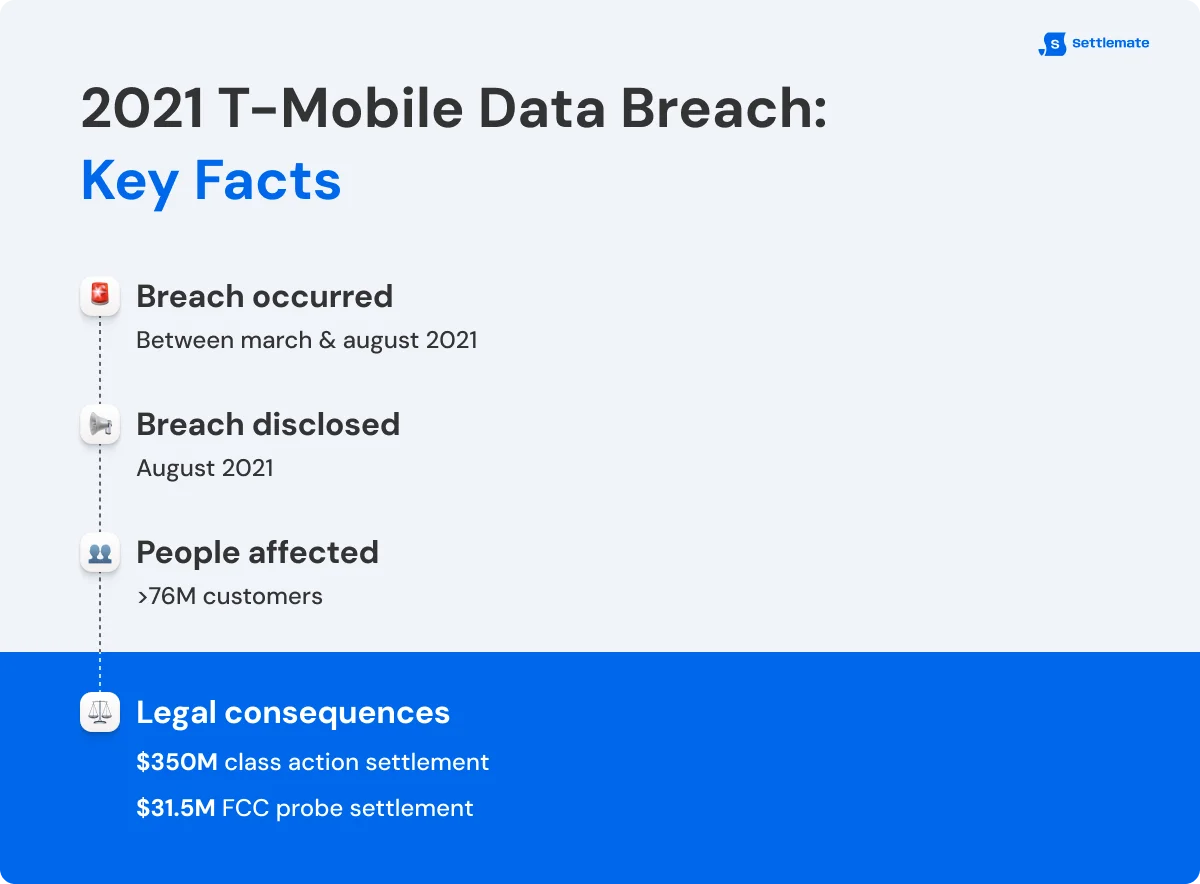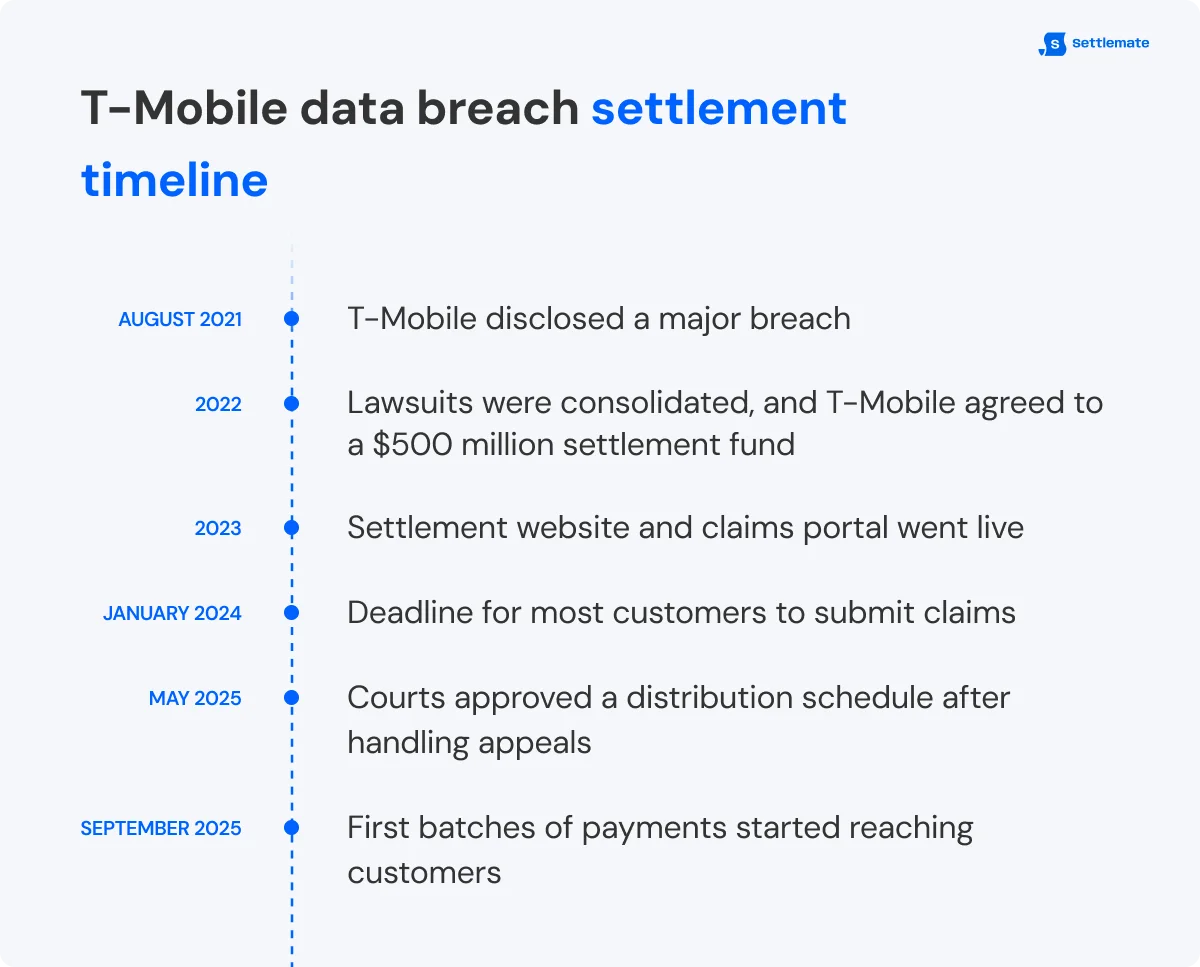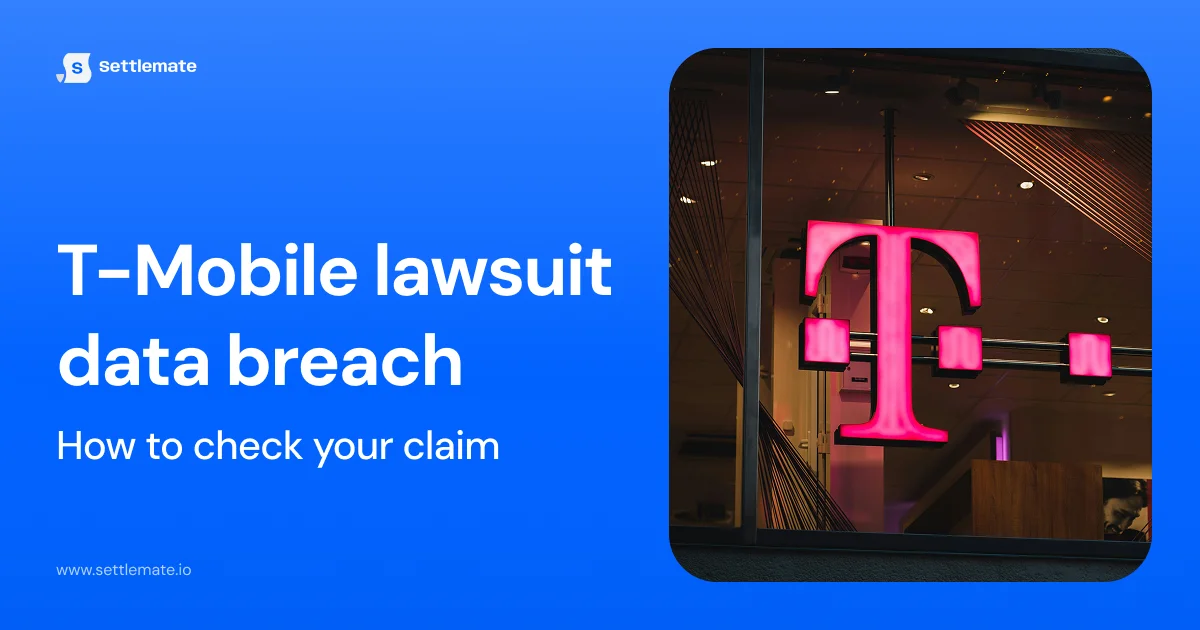In 2021, T-Mobile experienced one of the largest data breaches in U.S. history. Millions of customers had their personal details exposed, including phone numbers and Social Security numbers.
The class-action settlement ensures affected customers receive compensation and protection.
The problem is that most people never see the money they qualify for. Claims get buried in long forms, portals close quietly, and payout notices arrive months later when no one is looking. Many T-Mobile users who are entitled to compensation never complete the process or check their claim status.
In this guide, we’ll cut through the confusion with practical steps so you can confidently check your T-Mobile data breach claim and see what to do if you missed the claim deadline.
Key takeaways:
- Millions qualified for compensation: The 2021 T-Mobile data breach exposed personal data from about 76 million people. Anyone whose information was compromised qualified for the settlement, including former customers and applicants.
- Payments are finished: The settlement officially closed in 2025. The settlement administrator has closed all claim deadlines, issued payments, and stopped accepting new claims.
- Missed the claim? You’re still legally covered: Those who didn’t file are bound by the settlement release, meaning they can’t sue T-Mobile separately but still benefit from the free identity restoration protection.
- Stay ahead next time with Settlemate: Many people missed the T-Mobile payout simply because they didn’t know they had to claim it. Settlemate automatically scans for open class-action settlements, helps you file in minutes, and alerts you when payments are on the way, so you never miss another payout again.
What actually happened in the T-Mobile data breach?
T-Mobile is one of the largest wireless carriers in the United States, serving more than 100 million customers nationwide. Its size and reach made it a prime target for cybercriminals, and in 2021, those fears became reality.
In August 2021, T-Mobile announced that a major cyberattack had exposed the personal data of about 76 million customers.
Hackers accessed sensitive customer information, including:
- Names
- Addresses
- Social Security numbers
- Driver’s license details
- Birth dates
- Phone numbers
- Account PINs
- Other personal data
This was a full-on data heist affecting nearly one-third of Americans.

T-Mobile’s response left many customers furious. Multiple lawsuits started, accusing the company of failing to safeguard customer data. While T-Mobile denied wrongdoing, they couldn’t escape the public outcry and legal pressure. Customers felt betrayed as identity theft incidents surged, and even those who did not experience fraud directly grew anxious about their stolen information.
To avoid a protracted court battle, T-Mobile agreed to a landmark settlement. In mid-2022, the company proposed a $350 million class action settlement to compensate victims. A federal court granted preliminary approval in July 2022 and finalized the settlement on June 29, 2023. T-Mobile also committed to spending $150 million on security upgrades.

T-Mobile settlement timeline:
- August 16, 2021: T-Mobile discloses a data breach affecting about 76 million people.
- July 26, 2022: Court grants preliminary approval for the $350 million settlement.
January 23, 2023: Deadline to file claims. - June 29, 2023: Court gives final approval to the settlement.
- July 2023 – July 2024: Appeals filed and resolved in the Eighth Circuit.
- January 16, 2025: Court issues final order and closes all proceedings.
- May 2025: Settlement payments begin distribution to approved claimants.
- May 30, 2025: Settlement fully active; payments underway.
Who was eligible for the T-Mobile settlement?
Any U.S. resident whose personal information T-Mobile compromised in the August 2021 breach qualifies for the settlement. That’s roughly 76 million people nationwide.
If you received an official notice by email or postcard about the class action, that strongly indicates that you were eligible for the settlement.
But even if you didn’t see a notice, you qualify as long as your data was part of the breach (T-Mobile’s records identified the affected customers).
How to know if you were in the breach?
If you had a T-Mobile account around 2021 or before, there’s a good chance. T-Mobile confirmed the breach impacted past and present customers – even some prospective customers who had their credit checked. The exposed data included highly personal information (such as your SSN or driver’s license), so T-Mobile was required to notify the victims. You can double-check by contacting the settlement administrator or T-Mobile, but by now, most impacted folks have heard about it.
Excluded groups: A few people are not eligible despite being affected by the hack. This includes those who opted out of the class action or pursued individual legal claims or arbitration against T-Mobile before the settlement. Opting out was rare, and the deadline was late 2022. Also excluded are T-Mobile’s officers and directors and the judge’s family.
In short: Eligibility isn’t about being a current T-Mobile customer – it’s about being a victim of that 2021 breach. Even former customers qualify if their data was compromised. If you got hacked in that incident, you were in the class action (unless you took steps to exclude yourself).
What settlement benefits did participants receive?
The T-Mobile data breach settlement has officially ended. The settlement administrator has closed all claim deadlines, issued payments, and stopped accepting new claims. However, it’s still useful to understand what the settlement covered and what participants received.
Cash reimbursements for documented losses and time
During the active claim period, victims who incurred costs related to identity theft or fraud stemming from the T-Mobile breach could receive up to $25,000 in reimbursement.
Eligible expenses included:
- Credit monitoring or identity protection costs
- Fraud-related losses or charges
- Notary, postage, and administrative fees
- Credit freeze and unfreeze expenses
Claimants could also recover compensation for lost time:
- Up to 5 hours without documentation
- Up to 15 hours with proof of extensive fraud or identity theft issues
Alternative cash payment
Those who did not have documented losses could claim a flat alternative cash payment of $25, or $100 for California residents. The difference reflected California’s stronger privacy protections under state law. Claimants had to choose between documented reimbursement and the flat payment—they could not receive both.
Free identity protection for two years
The settlement offered two years of free identity protection services through Pango for those who filed valid claims. This included:
- Credit monitoring through TransUnion
- Dark web and identity theft monitoring
- Identity theft insurance up to $1 million
- Support for credit freezes and recovery
Automatic restoration services
Even people who did not file a claim remained eligible for restoration services through Pango. These services remain active and available to all class members who discover future identity misuse connected to the breach.
They include:
- Help with placing fraud alerts
- Disputing credit report errors
- Working with creditors and agencies to restore your identity
This benefit is ongoing and does not require a claim form.
Settlement fund and distribution
The settlement administrator (Kroll) began distributing payments to approved claimants in late May 2025. Payments rolled out over several weeks in June 2025.
How did payments arrive? Precisely as you selected on your claim form. The claim form lets people choose their payment method: PayPal, Venmo, Zelle, prepaid Mastercard, direct deposit, or paper check. Many people opted for electronic payments for speed. Indeed, some recipients received PayPal or Zelle deposits as early as June, while others got paper checks later, in July or August, especially if they didn’t set up an electronic payment option.
What people actually received
By mid-2025, T-Mobile breach victims started reporting their checks had arrived. For example, in Rhode Island, people received $25, while in California, they received $100, as expected. These figures matched the “alternative cash payment” amounts promised. Those who claimed out-of-pocket losses or lost time received varying amounts, depending on what they proved – typically a few hundred dollars if they had moderate documentation. One report mentioned individual payouts ranging from $25 up to around $375 for those who claimed significant time lost or minor losses.
How to check your T-Mobile settlement claim status
If you filed a claim, maybe back in 2022, and you’re wondering where your payment went, here’s how to confirm your status and what to do next:
1. Search your email for updates
Check your inbox and spam folders for messages from Kroll, the settlement administrator, or addresses ending in @t-mobilesettlement.com. These emails confirmed your claim and later notified you when payments were sent (usually between May and July 2025).
Search for terms like “T-Mobile settlement,” “Kroll,” or “class action payment.” If you find your Claim Number, keep it; it helps when contacting support.
2. Visit the official website
Go to t-mobilesettlement.com for official updates. While there’s no personal login, the site posts announcements and FAQ updates.
As of May 30, 2025, the administrator confirmed that payment distribution had begun. If any delays or issues occurred, they’ll appear in the site’s update or FAQ section.
3. Contact the settlement administrator
If you still haven’t received payment, reach out directly to Kroll:
- Phone: 1-833-512-2314
- Email: info@t-mobilesettlement.com
The administrator can tell you if they approved your claim, how much they awarded you, and how they sent your payment.
4. Check your payment method
Review the payment option you selected:
- PayPal, Venmo, or Zelle: Log in and check transactions from June–July 2025. Some payments were missed or unclaimed.
- Prepaid card or paper check: Review your mail from mid-2025 onward. Several people almost discarded their checks, thinking they were junk mail.
- If your digital payment failed, Kroll later mailed a paper check—sometimes after multiple inquiries. If you suspect this happened, call the administrator.
5. Use a claim-tracking tool for future settlements
For this case, your only options are email or direct contact. But for future claims, tools like Settlemate make the process easier. Settlemate scans your inbox for class-action updates, tracks claim progress automatically, and alerts you when payments are issued or reissued.
What to do if you didn’t file a claim (missed the deadline)
Missed out on filing a claim by January 2023? You’re not alone – with millions of people involved, plenty slipped through the cracks or didn’t realize they needed to take action.
Here’s the blunt truth:
You can’t get the cash or credit monitoring now
The deadlines are hard and final. If you didn’t submit a claim form by the cutoff (Jan 23, 2023), you won’t receive a $25 check or any other payment from this settlement. The settlement administrator has closed the claim process and announced no exceptions.
Some assumed T-Mobile would automatically send money because they had your info. Unfortunately, that’s not how this one worked. It was a “claims-made” settlement, meaning you had to proactively raise your hand (file a claim) to get paid.
You’re still covered by the settlement release
Even if you didn’t file for benefits, as long as you didn’t opt out, you’re still legally bound by the settlement. This means you gave up the right to sue T-Mobile separately for this data breach.
In exchange, you had the opportunity to claim benefits (which you didn’t use), and you still have the peace of mind of the Restoration Services benefit. But you can’t turn around now and start a new lawsuit to get more money – that window has closed.
Use the free fraud support
Use the free fraud support. Even if you didn’t file a claim, you still have access to identity restoration services at no cost.
If you spot signs of identity theft or fraud, contact Pango Restoration Services through the settlement hotline at 1-833-512-2314. They can help resolve issues like false loans or fraudulent bills. This protection remains available for all 76 million affected users, even after the settlement closed.
Learn for next time
Data breaches are unfortunately common, and T-Mobile itself has had subsequent breaches. If you missed this claim, use it as a learning experience. Next time you get a class action notice (or hear of a big breach settlement), ACT!
Even if the payout is small, it’s usually worth a few minutes to submit a claim online. Don’t leave your “free money” on the table going forward.
Stay on top of claims with Settlemate and never miss a payout again
Tracking a class action payout can be frustrating, and T-Mobile’s case proves it. It took nearly two years after the claim deadline for the money to arrive, with various delays and little communication in between. Most people don’t have time to check websites or call administrators for updates constantly, especially when you might be eligible for multiple settlements at once (think banking fees, product refunds, other data breaches, etc.).
That’s where Settlemate comes in as a game-changer. In plain terms, Settlemate is like your personal claims assistant. It finds and tracks class action settlements you’re eligible for, helps you file claims, and keeps you updated.
Here’s how using Settlemate can benefit you:
- Automatic settlement discovery: You no longer need to search the web for new settlements. Settlemate automatically scans for open class actions and matches them to your past purchases or accounts. If you were a T-Mobile customer, for example, the app could alert you that you’re eligible and ready to claim.
- Seamless claim filing: Settlemate helps you file faster by pre-filling your details and guiding you through each step. If proof is required, it can scan your inbox for receipts or statements so you don’t waste time guessing what to upload.
- Unified dashboard for all claims: Instead of visiting multiple settlement sites, Settlemate lets you track all your claims in one dashboard. You can see if a claim is pending, approved, or paid, without juggling different portals or hotlines.
- Real-time alerts: Settlemate notifies you of key updates, including final approvals, payment releases, and second-round distributions. The app keeps track of every filing and opt-out date so you never miss your window to claim.
In short, why leave money on the table? You were owed something from the T-Mobile data breach settlement – either you claimed it and want to ensure you get it, or you missed it and regret not filing.
From now on, let Settlemate do the hard work of tracking these claims for you.
Get the Settlemate app on the App Store or Google Play and instantly discover which settlements owe you money.









